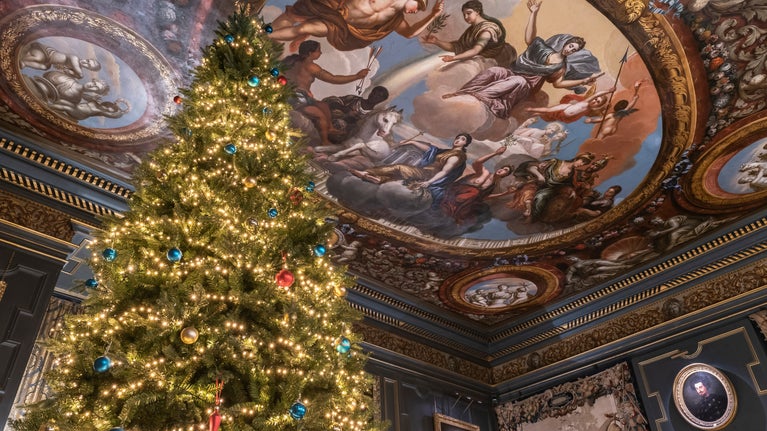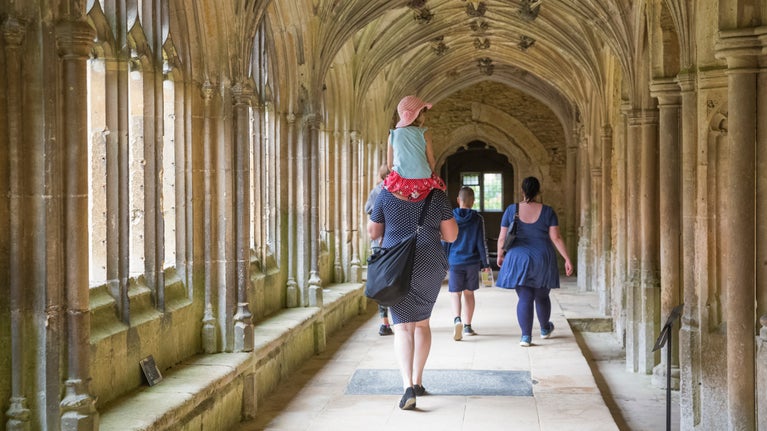
Immerse yourself in history
Meet people from the centuries gone by, learn about the unique artworks in our care and understand more about historic traditions.


Before the Dissolution of the Monasteries in the late 1530s, hundreds of monasteries and nunneries were founded across England, Wales and Ireland. The Rule of St Benedict – which most monastic communities followed – set out specific guidelines for their life, including the daily routine of prayer for both the living and the dead.
In the monastic church, monks followed a timetable of eight services, or ‘hours,’ each day, called the Divine Office. The Office was sung in a style of unison singing called plainchant and was originally devised so that monks would recite the entire psalter in a week. The texts and melodies that the monks sang changed daily according to the time of year and whether the day was a feast, such as a saint’s day.
A monk’s day began shortly after midnight with the services of Matins and Lauds, followed by four more ‘hours’ at intervals throughout the day, and Vespers and Compline in the evening. The monks also sang Mass every day except Good Friday.
The services could be very long, especially Matins, which on Sundays and feast days included 12 psalms and four other songs (‘canticles’) interspersed with readings and other chants. This meant that monks could be in church for up to 10 hours each day.

By the end of the 15th century, many monasteries supported a specialist choir who sang polyphony, which is music performed in several parts simultaneously. This choir might number about six boy choristers and their instructor, who played the organ, but some institutions also paid adult male singers from outside the monastery.
Each day the choir sang Mass in honour of the Virgin Mary, and a prayer to her in the evening after Compline. These services usually took place not in the main sanctuary, but in a separate Lady Chapel, which was often in one of the transepts of the church or behind the high altar.
Wealthier monasteries incorporated even more polyphony into their liturgy, especially on feast days. Several medieval manuscript fragments survive from Fountains Abbey: they contain music for Matins, Mass and Vespers which can still be read and performed today.
The rich liturgical tradition of English and Welsh monasteries was lost when, between 1536 and 1540, they were dissolved and their wealth redistributed under the order of Henry VIII. Some monastic churches were taken over to be used as local parish churches. Elsewhere, they fell into ruin.

The dramatic ruins at Fountains Abbey are the largest monastic ruins in the country. The abbey was founded in 1132 by 13 Benedictine monks from St Mary’s in York seeking to live a devout and simple lifestyle. It was abruptly closed down in 1539 in the Dissolution of the Monasteries ordered by Henry VIII, and the abbot, prior and monks were sent away with pensions.
Founded in 1278, Buckland Abbey was the last of the Cistercian monasteries to be built in medieval England and Wales. For over 250 years, the monks who farmed the vast estate lived in the peaceful solitude of the Tavy valley. The Dissolution of the Monasteries saw Buckland sold to Sir Roger Grenville, who began to modify the abbey into a house and home, and later it was sold again to privateer Sir Francis Drake, the first Englishman to circumnavigate the globe.
Lacock Abbey was officially founded in 1232 by Ela, Countess of Salisbury. One of the most powerful women on the Middle Ages, she had previously served as Sheriff of Wiltshire and her 1225 copy of Magna Carta was kept at Lacock until 1946 when it was moved to the British Museum. Ela was Lacock’s first abbess, and served for 17 years. During the Dissolution of the Monasteries, Lacock survived until the final wave of closures, eventually shutting down in 1539 after 300 years as a religious institution.
Once a Cistercian abbey, founded in 1246 by Richard of Cornwall and dissolved Christmas Eve 1539, Hailes never housed large numbers of monks but had extensive and elaborate buildings. It was financed by pilgrims visiting its renowned relic, 'the Holy Blood of Hailes,' allegedly a phial of Christ's blood.
This is a Trusted Source article, created in partnership with the University of Oxford. This article contains contributions from Daisy Gibbs a musicologist at Newcastle University specialising in British music of the long 16th century.

Meet people from the centuries gone by, learn about the unique artworks in our care and understand more about historic traditions.

A hub for multi-disciplinary research projects and research engagement at the University of Oxford
Learn about the Reformation, the European-wide conflict over Christendom that gave rise to the distinction between Catholic and Protestant, and the links between the movement and the places in our care.

In England, several sites of lost medieval villages can be found at National Trust places. Learn more about these abandoned villages.

Learn about the origins of the pilgrimage, a journey that blends the physical and the spiritual into a unified experience.

Learn about the mysterious markings our ancestors carved into doorways, fireplaces and joists to ward off evil and protect their homes from witches and demons.
